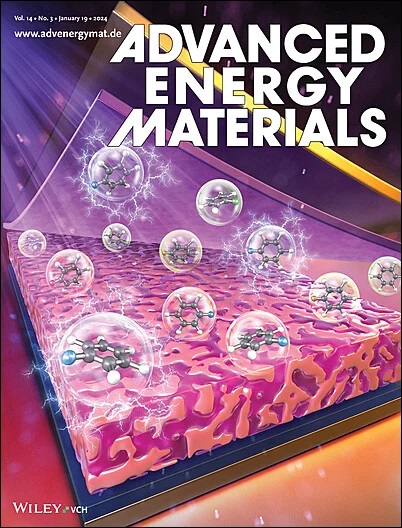Viscoelastic Soft Solid Electrolytes Enable Fast Zinc Ion Conductance and Highly Stable Zinc Metal Anode
IF 24.4
1区 材料科学
Q1 CHEMISTRY, PHYSICAL
引用次数: 0
Abstract
Achieving both high ionic conductance and stable Zn metal anode simultaneously remains a challenge with current liquid and solid electrolytes. Here, a viscoelastic soft solid electrolyte (VSSE) strategy is presented that effectively balances Zn ion conduction and Zn anode stability. The VSSE is created by nano‐SiO粘弹性软固体电解质使锌离子电导快速,锌金属阳极高度稳定
同时实现高离子电导率和稳定的锌金属阳极仍然是目前液体和固体电解质的挑战。本文提出了一种粘弹性软固体电解质(VSSE)策略,可以有效地平衡锌离子传导和锌阳极的稳定性。VSSE是通过纳米SiO2在含有Zn(BF4)2盐溶解于低聚物(甘油聚氧乙烯-乙氧丙烯醚,GPE)和水的液体溶液中诱导液-固过渡而产生的。水凝胶中丰富的氧官能团为水分子完全氢键形成无游离水的状态提供了足够的氢键位点。结合水作为Zn - O配位调节剂,可以减弱Zn - O的强配位,降低Zn离子的解离能,实现Zn离子的快速解耦运动模式。因此,在室温下,VSSE的Zn离子电导率为(2.28±0.07)×10−3 S cm−1,比报道的固体聚合物电解质高10-1000倍。同时,结合水分子活性的限制使得锌金属阳极具有优异的储存/循环寿命,这一点得到了显著提高的储存寿命(720小时)、搁置-恢复寿命(850-1200小时)和循环寿命(1400-2050小时)的证实。该研究为基于软物质科学的多功能电解质设计策略提供了新的视角。
本文章由计算机程序翻译,如有差异,请以英文原文为准。
求助全文
约1分钟内获得全文
求助全文
来源期刊

Advanced Energy Materials
CHEMISTRY, PHYSICAL-ENERGY & FUELS
CiteScore
41.90
自引率
4.00%
发文量
889
审稿时长
1.4 months
期刊介绍:
Established in 2011, Advanced Energy Materials is an international, interdisciplinary, English-language journal that focuses on materials used in energy harvesting, conversion, and storage. It is regarded as a top-quality journal alongside Advanced Materials, Advanced Functional Materials, and Small.
With a 2022 Impact Factor of 27.8, Advanced Energy Materials is considered a prime source for the best energy-related research. The journal covers a wide range of topics in energy-related research, including organic and inorganic photovoltaics, batteries and supercapacitors, fuel cells, hydrogen generation and storage, thermoelectrics, water splitting and photocatalysis, solar fuels and thermosolar power, magnetocalorics, and piezoelectronics.
The readership of Advanced Energy Materials includes materials scientists, chemists, physicists, and engineers in both academia and industry. The journal is indexed in various databases and collections, such as Advanced Technologies & Aerospace Database, FIZ Karlsruhe, INSPEC (IET), Science Citation Index Expanded, Technology Collection, and Web of Science, among others.
 求助内容:
求助内容: 应助结果提醒方式:
应助结果提醒方式:


